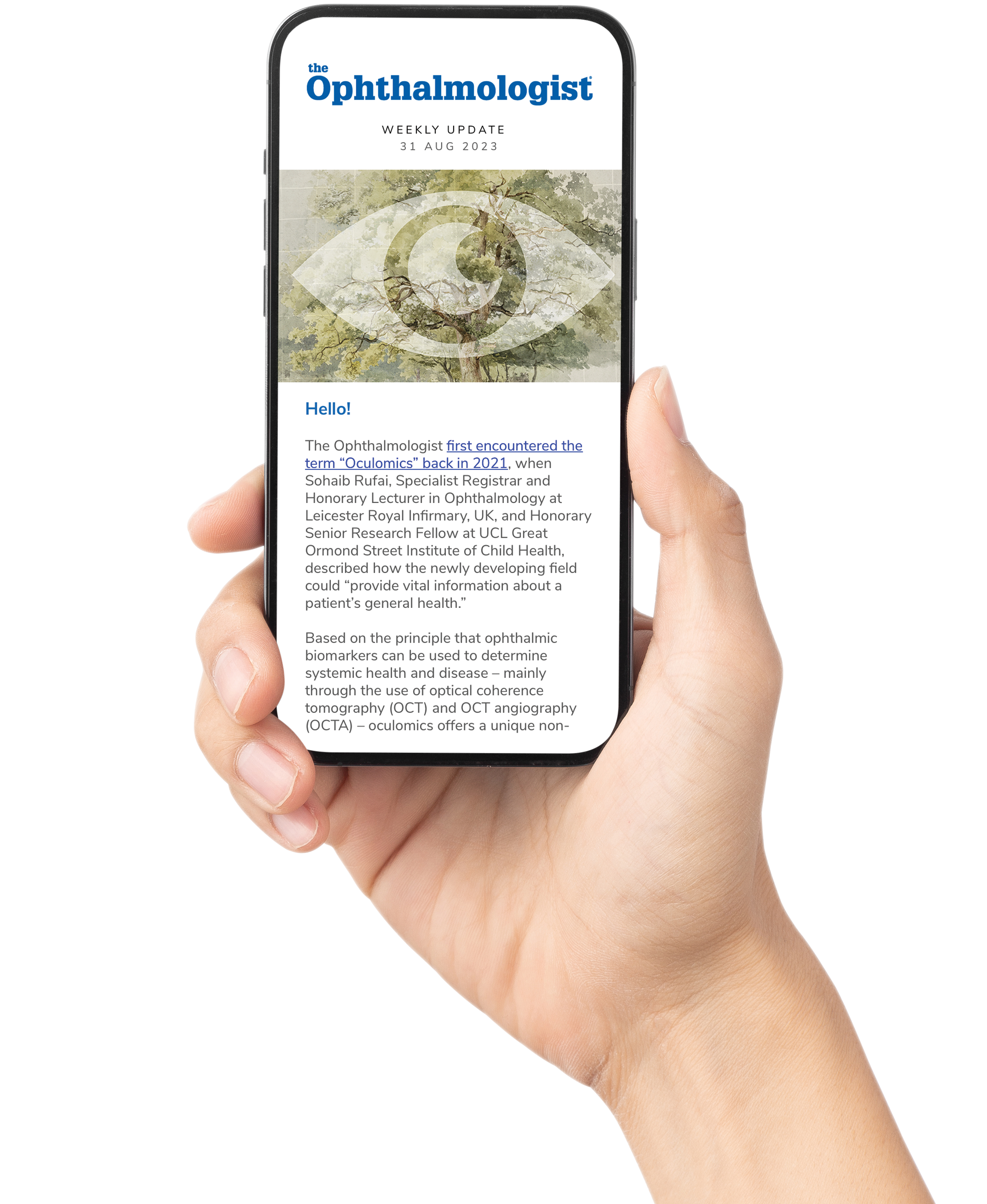Following on from a late-breaking presentation at the 25th EURETINA Congress, Susan Schneider, Acting Chief Medical Officer of Ashvattha Therapeutics, sat down with The Ophthalmologist to discuss migaldendranib (MGB). MGB is the company’s investigational first-in-class subcutaneous nanomedicine currently under development for the treatment of diabetic macular edema (DME) and neovascular age-related macular degeneration (nAMD).

You recently presented phase II data for migaldendranib (MGB) at EURETINA – what are the most important topline findings ophthalmologists should know about?
MGB is a novel, targeted, nanomedicine offering a subcutaneous route of administration for patients with ocular disease. With the 40 -week phase II data, what's really exciting to us is, first and foremost, safety. This is a safe drug, systemically delivered, through subcutaneous administration. It's demonstrated an excellent safety profile and was very well tolerated. From a safety perspective, we saw no ocular or systemic serious adverse events that were deemed MGB related.
There have been some questions about safety with systemic TKIs (Tyrosine Kinase Inhibitors) in the past, and so we looked very carefully at systemic safety, not just at adverse events, but also at lab values and other test results. Specifically, there were no clinically significant changes from baseline in renal, hepatic, or cardiac values while on study.
There were no ocular adverse events at all that were deemed MGB treatment-related. The most common adverse event related to MGB was injection site reactions. But even these were not common – they were localized, transient, and mostly mild. None of them were severe. When we looked closely at the data, what we saw with injection site reactions was that many of them were reported only after the first subcutaneous administration, and not thereafter.
One of the things that we find quite interesting, particularly with DME patients, is that these patients are familiar with subcutaneous administration. We believe that this will be well accepted in the community as we move the program forward.
In terms of efficacy, how did MGB perform?
We presented interim 24-week data earlier in the year, and what we are excited to report is that the 40-week top line data that we just presented at EURETINA are highly consistent with the 24-week interim data..
We saw a bilateral treatment effect for subcutaneous MGB. With intravitreal injections, because you inject in only one eye, you can only report data for the designated study eye. But we can see fellow eye effects as well, and we saw a bilateral treatment effect via subcutaneous administration with MGB after single dosing. We find that very compelling.
We saw clinically meaningful improvements in best corrected visual acuity and central subfield thickness in the DME study eyes, particularly, with a mean change from baseline in best corrected visual acuity in the DME study eyes of 6.1 ETDRS letters.
When we looked at the wet AMD study eyes, we also saw consistent improvements in best corrected visual acuity and central subfield thickness, that was about five letters, and about 63 microns, mean change from baseline, respectively. The reason why the mean change from baseline is important for best corrected visual acuity is that, for the next study, it is intended to be the primary endpoint.
We plan to move forward with an anti-VEGFcomparator arm in the next study. These results give us confidence in next steps.
In addition, we looked at fellow eye results. These eyes generally had better vision and less central subfield thickness than designated study eyes. What's interesting is that we saw stable best corrected visual acuity and central subfield thickness while on study in both DME and wet AMD fellow eyes. These fellow eye results were in participants that came into the study with bilateral disease and who were previously treated with anti-VEGF intravitreal injections. This bilateral treatment effect is quite compelling.
Importantly, we also saw a marked reduction in the need for supplemental intravitreal anti-VEGF injections (aflibercept). This was actually in both eyes and in both indications. These are exciting results.
As you know, compliance can be an issue with these patients. When you have to come into the office on a regular basis to get an intravitreal injection in one or both eyes, compliance becomes an issue particularly as you get past the first year of receiving treatment. What we believe is really a differentiator for this drug, MGB, moving forward, is that subcutaneous administration has the possibility to be an at-home monthly administration. With at-home administration, there might also be the possibility of at-home OCT monitoring. Patients might only need to come into the office to receive a supplemental anti-VEGF intravitreal injection if needed, and for routine examinations otherwise.
What kind of patient training would be needed to ensure safe self-administration outside the clinic?
Many of these patients, particularly DME patients, are very familiar with subcutaneous administration with insulin or GLP 1s. We are targeting monthly administration and developing an auto-injector. We would be doing training to coincide with the launch of the product.
Can you explain how MGB’s mechanism differs from existing anti-VEGF therapies?
MGB is a VEGF receptor tyrosine kinase inhibitor covalently linked to hydroxyl dendrimer. MGB is actually a new drug, a new chemical entity. The covalent linkage to the TKI makes it larger than a small molecule; it's almost 20 kilodaltons. It's not a prodrug. It's not metabolized. Versus other systemic TKI's, it's renally cleared. We believe that these attributes address the safety issues previously seen with systemic (oral) TKI's.
When we look at current intravitreal TKIs in development, MGB is different in that it normalizes VEGF expression and targets activated macrophages and microglia, and hypoxic retinal pigment epithelial (RPE) cells, as opposed to targeting inhibiting VEGF signaling and vascular endothelial cells. Collectively, these attributes distinguish MGB as a first-in-class therapeutic with a differentiated mechanism of action compared to both existing anti-VEGF agents and intravitreal TKIs in development.
How do you see MGB fitting into current treatment algorithms for both DME and nAMD?
We believe that MGB would become an important tool in the treatment toolbox. This drug could potentially be used as a first-line treatment to normalize VEGF expression, with supplemental anti-VEGF intravitreal injections used as needed.
What are the next clinical development steps for MGB following these phase II results?
Typically, in clinical development, the next steps would be a larger study, with an active comparator, and that's where our focus is currently. We remain excited about the further development of MGB.
